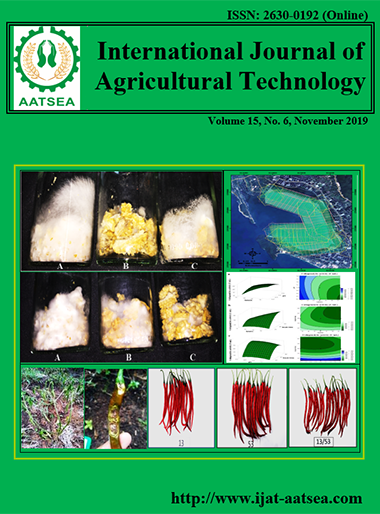Philippine agricultural corn cob wastes as alternative spawning materials for three Pleurotus species
Main Article Content
Abstract
In the pursuit of finding cheaper but efficient materials for spawn production, agricultural wastes such as corn cobs were utilized as carriers of mycelia instead of common grains. Cobs of sweet corn cobs, glutinous corn, and yellow corn were evaluated as possible spawning materials for the mother culture of Pleurotus pulmonarius, Pleurotus florida, and Pleurotus sajor-caju. Among the three varieties of corn cobs tested, sweet corn cob was found to be the best spawning material for Pleurotus species with the shortest incubation period, 10.40 days for P. pulmonarius; 10.20 days for P. florida, and 10.60 days for P. sajor-caju. These species of Pleurotus had luxuriant mycelial growth, with very thick mycelial density recorded on sweet corn cobs. This is a benchmark study in the utilization of three corn varieties as efficient spawning materials for the mother culture of three Pleurotus species.
Article Details

This work is licensed under a Creative Commons Attribution-NonCommercial-NoDerivatives 4.0 International License.
References
Bao, J., Yao, J., Zhu, J., Hu, W., Cai, D., Li, Y., Shu, Q. and Fan, L. (2012). Identification of glutinous maize landraces and inbred lines with altered transcription of waxy gene. Molecular Breeding, 30:1707-1714.
Bunge, J. (2011). Typical composition of yellow dent corn. California, Berkeley, USA, pp. 13-28.
Mandeel, Q., Al-Laith, A. and Mohamed, S. (2005). Cultivation of oyster mushrooms (Pleurotus spp.) on various lignocellulosic wastes. World Journal of Microbiology and Biotechnology, 21:601-607.
Oei, P. (1991). Manual on mushroom cultivation: Techniques, species and opportunities for commercial application in developing countries. TOOL (Transfer of Technology for Development) Publications, Amsterdam, pp. 1-26.
Soko, M., Madula, M., Mankhwanda, T., Langisi, Z. and Banda, A. (2007). Evaluations of different possible Pleurotus spp. planting spawn media for use in the spawn industry. Bvumbe Research Station, Limbe, pp. 32-40.
Stamets, P. (2000). Growing gourmet and medicinal mushrooms. Ten Speed Press, Berkeley, CA, pp. 121-126.
Tesfaw, A., Tadesse, A. and Kiros, G. (2015). Optimization of oyster (Pleurotus ostreatus) mushroom cultivation using locally available substrates and materials in Debre Berhan, Ethiopia. Journal of Applied Biology & Biotechnology, 3:15-20.
Wright, S. (2014). Sweet corn. University of Kentucky, College of Agriculture, Food and Environment. Center for Crop Diversification Profile. Cooperative Extension Service. USA, pp. 1-4.


